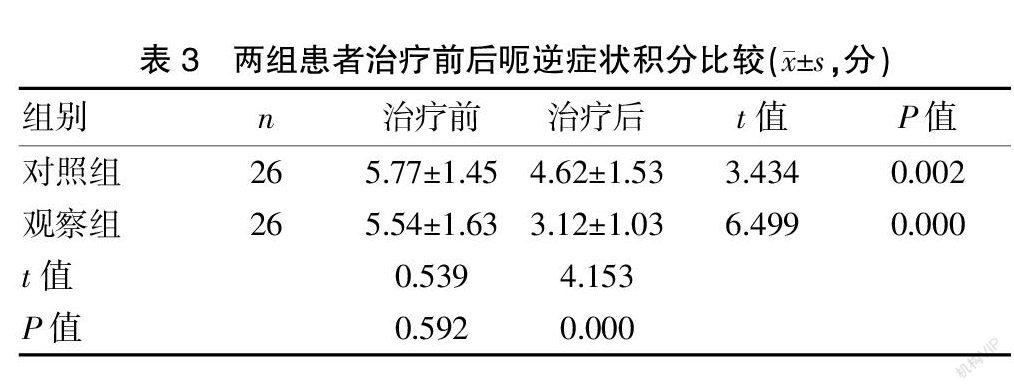揿针联合坐位咳嗽疗法对脑卒中后气管切开患者顽固性呃逆的疗效观察
2021-10-26戴允兰章微微孙鹏曾雅琴
戴允兰 章微微 孙鹏 曾雅琴



[摘要] 目的 探讨揿针联合坐位咳嗽疗法对治疗脑卒中后气管切开患者顽固性呃逆的临床疗效。 方法 选取浙江省人民医院2018年11月至2020年10月收治的脑卒中后气管切开顽固性呃逆住院患者52例,根据随机数字表法将其分为观察组和对照组,每组各26例,观察组采取揿针联合坐位咳嗽疗法治疗顽固性呃逆,对照组采取常规的盐酸氯丙嗪注射液+盐酸甲氧氯普胺注射液(胃复安)联合治疗,疗程均为6 d。通過对两组患者治疗前后的生活质量评分、呃逆症状积分、咳嗽反射分级量表评分等观察指标进行科学评价,观察其最终的临床疗效。 结果 治疗后,与对照组相比,观察组的呃逆症状积分[(4.62±1.53)分 vs. (3.12±1.03)分]、咳嗽反射分级量表评分[(2.35±0.63)分 vs. (1.69±0.55)分]均降低,观察组的生活质量评分[(10.15±1.38)分 vs. (11.38±1.79)分]、总有效率(92.3% vs. 73.1%)均增高(P<0.05)。 结论 揿针联合坐位咳嗽诱发与常规的药物治疗对脑卒中后气管切开患者的顽固性呃逆均有一定的疗效,但前者的治疗效果优于后者,可明显提高患者的生活质量,改善患者的呃逆症状,前者对咳嗽反射重塑效果明显优于后者,可以进一步促进气道分泌物的排出,值得临床推广应用。
[关键词] 揿针;坐位咳嗽;脑卒中;气管切开;顽固性呃逆
[中图分类号] R473.6;R744.5 [文献标识码] A [文章编号] 1673-9701(2021)24-0028-05
Observation of curative effect of sitting position cough therapy combined with press needle on obstinate hiccup in patients with post-stroke tracheotomy
DAI Yunlan ZHANG Weiwei SUN Peng ZENG Yaqin
Department of Rehabilitation Medicine, Zhejiang Provincial People′s Hospital, People′s Hospital of Hangzhou Medical College, Hangzhou 310014, China
[Abstract] Objective To explore the clinical effect of needle-embedding combined with sitting cough induction on intractable hiccups in patients with tracheotomy after stroke. Methods A total of 52 tracheotomy patients with intractable hiccups after stroke admitted to Zhejiang Provincial People′s Hospital from November 2018 to October 2020 were selected and divided into observation group and control group according to the random number table method, with 26 cases in each group. The observation group was treated with needle-embedding combined with sitting cough induction for the treatment of intractable hiccups, and the control group was treated with conventional chlorpromazine hydrochloride injection combined with metoclopramide hydrochloride injection (metoclopramide). The course of treatment was six days. Through scientific evaluation of the quality of life scores, hiccup symptom scores, cough reflex grading scale scores of the two groups before and after treatment, the final clinical efficacy was observed. Results After treatment, compared with (4.62±1.53) points and (2.35±0.63) points in the control group, the scores of hiccups [(3.12±1.03) points] and cough reflex grading scale scores [(1.69±0.55) points] in the observation group were all decreased. Compared with (10.15±1.38) points and (73.1%) in the control group, the quality of life scores [(11.38±1.79) points] and total effective rate (92.3%) of the observation group increased (P<0.05). Conclusion Needle-embedding combined with sitting cough induction and conventional medical treatment have certain effects on intractable hiccups after tracheotomy in patients with stroke, but the former has better therapeutic effects than the latter, which can significantly improve the quality of life of patients and improve patients′ hiccup symptoms. The former has a significantly better effect on remodeling the cough reflex than the latter, which can further promote the discharge of airway secretions and is worthy of clinical application.
